#garden species
Explore tagged Tumblr posts
Photo


Cerasus sato-zakura group ‘grandiflora'
398 notes
·
View notes
Text

2K notes
·
View notes
Text
Good News - July 22-28
Like these weekly compilations? Tip me at $kaybarr1735 or check out my new(ly repurposed) Patreon!
1. Four new cheetah cubs born in Saudi Arabia after 40 years of extinction

“[T]he discovery of mummified cheetahs in caves […] which ranged in age from 4,000 to as recent as 120 years, proved that the animals […] once called [Saudi Arabia] home. The realisation kick-started the country’s Cheetah Conservation Program to bring back the cats to their historic Arabian range. […] Dr Mohammed Qurban, CEO of the NCW, said: […] “This motivates us to continue our efforts to restore and reintroduce cheetahs, guided by an integrated strategy designed in accordance with best international practices.””
2. In sub-Saharan Africa, ‘forgotten’ foods could boost climate resilience, nutrition

“[A study published in PNAS] examined “forgotten” crops that may help make sub-Saharan food systems more resilient, and more nutritious, as climate change makes it harder to grow [current staple crops.] [… The study identified 138 indigenous] food crops that were “relatively underresearched, underutilized, or underpromoted in an African context,” but which have the nutrient content and growing stability to support healthy diets and local economies in the region. […] In Eswatini, van Zonneveld and the World Vegetable Center are working with schools to introduce hardy, underutilized vegetables to their gardens, which have typically only grown beans and maize.”
3. Here's how $4 billion in government money is being spent to reduce climate pollution

“[New Orleans was awarded] nearly $50 million to help pay for installing solar on low to middle income homes [… and] plans to green up underserved areas with trees and build out its lackluster bike lane system to provide an alternative to cars. […] In Utah, $75 million will fund several measures from expanding electric vehicles to reducing methane emissions from oil and gas production. [… A] coalition of states led by North Carolina will look to store carbon in lands used for agriculture as well as natural places like wetlands, with more than $400 million. [… This funding is] “providing investments in communities, new jobs, cost savings for everyday Americans, improved air quality, … better health outcomes.””
4. From doom scrolling to hope scrolling: this week’s big Democratic vibe shift

“[Democrats] have been on an emotional rollercoaster for the past few weeks: from grim determination as Biden fought to hang on to his push for a second term, to outright exuberance after he stepped aside and Harris launched her campaign. […] In less than a week, the Harris campaign raised record-breaking sums and signed up more than 100,000 new volunteers[….] This honeymoon phase will end, said Democratic strategist Guy Cecil, warning the election will be a close race, despite this newfound exuberance in his party. [… But v]oters are saying they are excited to vote for Harris and not just against Trump. That’s new.”
5. Biodegradable luminescent polymers show promise for reducing electronic waste

“[A team of scientists discovered that a certain] chemical enables the recycling of [luminescent polymers] while maintaining high light-emitting functions. […] At the end of life, this new polymer can be degraded under either mild acidic conditions (near the pH of stomach acid) or relatively low heat treatment (> 410 F). The resulting materials can be isolated and remade into new materials for future applications. […] The researchers predict this new polymer can be applied to existing technologies, such as displays and medical imaging, and enable new applications […] such as cell phones and computer screens with continued testing.”
6. World’s Biggest Dam Removal Project to Open 420 Miles of Salmon Habitat this Fall

“Reconnecting the river will help salmon and steelhead populations survive a warming climate and [natural disasters….] In the long term, dam removal will significantly improve water quality in the Klamath. “Algae problems in the reservoirs behind the dams were so bad that the water was dangerous for contact […] and not drinkable,” says Fluvial Geomorphologist Brian Cluer. [… The project] will begin to reverse decades of habitat degradation, allow threatened salmon species to be resilient in the face of climate change, and restore tribal connections to their traditional food source.”
7. Biden-Harris Administration Awards $45.1 Million to Expand Mental Health and Substance Use Services Across the Lifespan
““Be it fostering wellness in young people, caring for the unhoused, facilitating treatment and more, this funding directly supports the needs of our neighbors,” said HHS Secretary Xavier Becerra. [The funding also supports] recovery and reentry services to adults in the criminal justice system who have a substance use disorder[… and clinics which] serve anyone who asks for help for mental health or substance use, regardless of their ability to pay.”
8. The World’s Rarest Crow Will Soon Fly Free on Maui

“[… In] the latest attempt to establish a wild crow population, biologists will investigate if this species can thrive on Maui, an island where it may have never lived before. Translocations outside of a species’ known historical range are rare in conservation work, but for a bird on the brink of extinction, it’s a necessary experiment: Scientists believe the crows will be safer from predators in a new locale—a main reason that past reintroduction attempts failed. […] As the release date approaches, the crows have already undergone extensive preparation for life in the wild. […] “We try to give them the respect that you would give if you were caring for someone’s elder.””
9. An optimist’s guide to the EV battery mining challenge
““Battery minerals have a tremendous benefit over oil, and that’s that you can reuse them.” [… T]he report’s authors found there’s evidence to suggest that [improvements in technology] and recycling have already helped limit demand for battery minerals in spite of this rapid growth — and that further improvements can reduce it even more. [… They] envision a scenario in which new mining for battery materials can basically stop by 2050, as battery recycling meets demand. In this fully realized circular battery economy, the world must extract a total of 125 million tons of battery minerals — a sum that, while hefty, is actually 17 times smaller than the oil currently harvested every year to fuel road transport.”
10. Peekaboo! A baby tree kangaroo debuts at the Bronx Zoo

“The tiny Matschie’s tree kangaroo […] was the third of its kind born at the Bronx Zoo since 2008. [… A] Bronx Zoo spokesperson said that the kangaroo's birth was significant for the network of zoos that aims to preserve genetic diversity among endangered animals. "It's a small population and because of that births are not very common," said Jessica Moody, curator of primates and small mammals at the Bronx Zoo[, …] adding that baby tree kangaroos are “possibly one of the cutest animals to have ever lived. They look like stuffed animals, it's amazing.””
July 15-21 news here | (all credit for images and written material can be found at the source linked; I don’t claim credit for anything but curating.)
#hopepunk#good news#cheetah#extinct species#africa#nutrition#food#farming#gardening#pollution#climate#climate change#climate crisis#democrats#us politics#us elections#kamala harris#voting#recycling#biodegradable#technology#salmon#habitat#fish#mental illness#mental health#substance abuse#hawaii#electric vehicles#zoo
858 notes
·
View notes
Note
On my knees begging for anything trans!Obi-Wan :') love your work btw
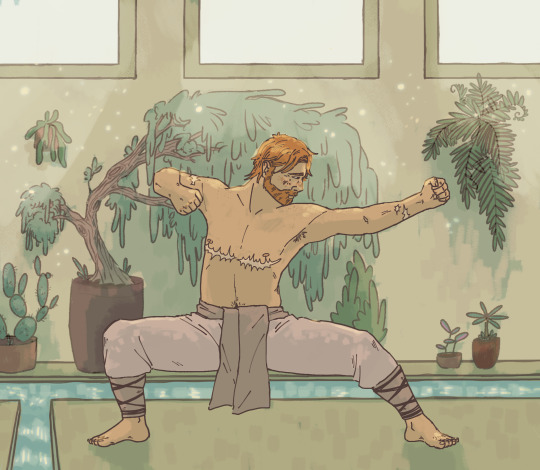
your wish is my comand lovely anon, here's obi-wan having a nice peaceful moment training
#art requests#i got perhaps a little carried away i cant lie buuuuut im very happy with this#first thing ive really drawn in like 6 months#i came up with a silly over complicated lore for the tree in the background because .. well you gotta think about something when you draw#its a short lived species that picks a direction and grows in it until it falls over and dies and lots of smaller ones grow up in its place#and yoda plants them around the creche / training areas/ gardens / wherever and they act as a lesson in attachemnt for younglings :)#like yes this tree thats been around all your life (10 years or less) is dead but look it dying has made new trees and new opportunities#and maybe sometimes he gifts them to younglings he likes or ones he thinks could use the reminder sometimes that things ending isnt the end#new stuff happens after everything continues its all fine#anakin definitely recieved one or ten#probably was still recieving them into knighthood because yoda is a troll#he doesnt know theyre supposed to collapse and die though he just thinks hes really bad at looking after plants#anyways#yep#done with that#my art <3#cal draws#obiwan kenobi#trans obi wan#trans obi wan kenobi#trans! obiwan#star wars#star wars fanart#fanart
277 notes
·
View notes
Text


Lysimachia Arvensis! 🌸 More commonly known as scarlet pimpernel. They live around Europe, Western Asia, and North Africa. Their really small too! I love taking pics of these guys because the color is so pretty and dew drops collect super easily on them. Also every time I see them I think of the lesbian flag cuz one of the colors is kinda similar lol
#flowers#Small flowers#dewdrops#nature photography#photography#plants#garden#plant species#aesthetic#fairycore#Don’t use my stuff without permissionnnnnn
314 notes
·
View notes
Text
"Next Monday [6/17/24] is the start of National Pollinator Awareness Week, and one Colorado advocacy group is hosting a flower planting drive to rewild Colorado’s meadows, gardens, and just maybe, its children too.
Created by constitutional amendment in 1992, Great Outdoors Colorado (GOCO) is a state-funded independent board that invests a portion of Colorado Lottery proceeds to help preserve and enhance the state’s parks, trails, wildlife, rivers, and open spaces.
This year, GOCO’s offshoot Generation Wild is distributing over 100,000 free packets of wildflower seeds to collection points at museums, Denver Parks and Rec. offices, and libraries all over the state to encourage kids and families to plant the seeds in their backyards.
The Save the Bees! initiative aims to make the state more beautiful, more ecologically diverse, and more friendly to pollinators.
According to a new report from the Colorado Department of Natural Resources, 20% of Colorado’s bumblebees are now at risk of extinction. Even in a small area like a backyard, planting wildflowers can make a positive impact on the local ecosystem and provide native bees with a healthy place to live.
“The Western Bumblebee population has declined in Colorado by 72%, and we’re calling on kids across Colorado to ‘bee’ the change,” said GOCO Executive Director Jackie Miller.
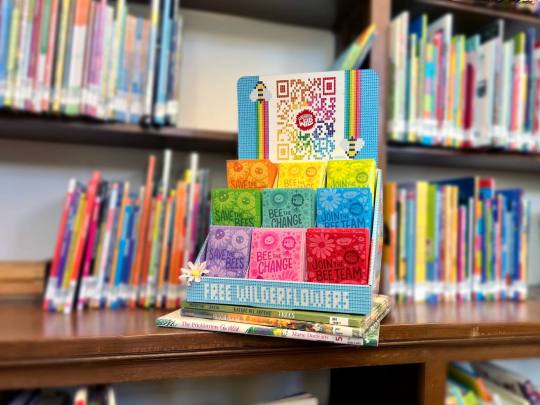
Named after Generation Wild’s official mascot “Wilder,” the Wilderflower Seed Mix was developed in partnership with Applewood Seed Co. and packets are now available for pickup at designated partner sites including more than 80 Little Free Library boxes.
By distributing 100,000 Wilderflower packets, Generation Wild is providing more than 56 million seeds for planting in every nook and cranny of the state. All seeds are regionally-native to Colorado, which is important for sustaining the living landscape of bees, birds, and other animals.
Additionally, by using flower species adapted to the Mile High climate, landscapers and gardeners need to use less water than if they were tending non-native plants.
“Applewood Seed Co. was excited to jump in and help Generation Wild identify a seed mix that is native to the Colorado region and the American West, containing a diversity of flower species to attract and support Colorado’s pollinator populations,” stated Norm Poppe, CEO of Applewood Seed Co. “We hope efforts like this continue to educate the public on pollinator conservation and the need to protect our native bees and butterflies.”
Concluding her statement Miller firmly stated that children grow up better outside, and if you or a parent you know agree with her, all the information on how to participate in Save the Bees! can be found here on their website, including a map showing all the local pickup points for the Wilderflower Seed Packets."
-via Good News Network, June 13, 2024
#wildflowers#wild flowers#colorado#bees#native bees#entomology#insects#save the bees#pollinators#bumblebees#bumble bee#i love bees#biodiversity#native plants#urban gardening#gardening#ecology#conservation#endangered species#wildlife conservation#enviromentalism#good news#hope#hope posting#solarpunk#denver#boulder colorado#colorado springs#libraries#public libraries
485 notes
·
View notes
Text




Plant of the Day
Monday 13 January 2025
Found along a pathway in an urban situation was this casccade of goji berries on Lycium barbarum (Duke of Argyll's tea tree, Barbary box thorn, Barbary wolfberry, Chinese box thorn, matrimony vine, Tibetan goji berry, vicar's tea party, European box thorn). This scrambling, deciduous shrub can reach up to 3m tall. The flexible spiny stems have narrow, dull green leaves and small, dull purple flowers in late spring and summer. The species can be invasive.
Jill Raggett
#Lycium#Duke of Argyll's tea tree#Barbary box thorn#Barbary wolfberry#Chinese box thorn#matrimony vine#Tibetan goji berry#vicar's tea party#European box thorn#invasive species#plants#horticulture#urban landscape#garden#kent#Deal#deciduous#shrub#fruit#spiny stem
174 notes
·
View notes
Text




black bees
2024/06/08
#photography#photographers on tumblr#nature#naturecore#nature photography#aesthetic#flowers#adventure#flora#poland#garden#botanical garden#botanic#black bee#bee#protected#protected species#insect
290 notes
·
View notes
Text


#HMMM#no thots head empty#thoughts....sorry#Rick Grimes#*#rg#The Ones Who Live#sorry i missed sinday with this one#let's sin on Monday#tag yourself i'm below the frame#i used to famously find these shots in the OG series#pretty sure i made a gifset#bout to invest in those kneeling pads people who garden a lot use#excuse me but The Nose™#i have an interview tomorrow for a promotion let me have my trash ok#you look great in red babe#there's a species of bird called a swallow#that's me#*SIRENS WAILING* *GLASS BREAKING* *CAR HORNS* *AWHOOOGA* *DOGS BARKING*#*me on my lawn apologizing to CBS News while their helicopter circles overhead*
404 notes
·
View notes
Text
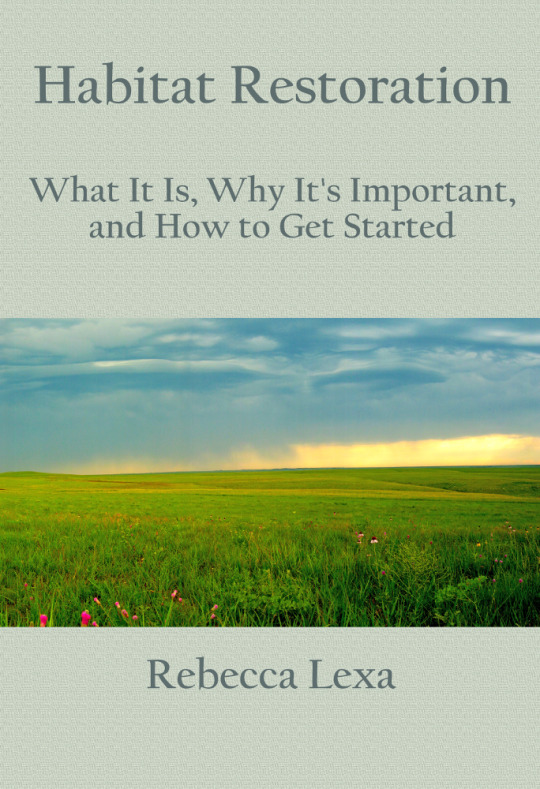
Happy Spring! I've just released my newest quarterly chapbook, Habitat Restoration: What It Is, Why It’s Important, and How to Get Started.
Habitat loss is the single biggest cause of species becoming endangered or extinct. Thankfully, we can help our local animals, plants, and other beings by restoring their habitat–even in our own backyards, gardens, and porches! Get the basics of what you need to know about:
What habitat restoration is
Why it’s important
How to get started
Troubleshooting your restoration project
Further resources
Whether you’re an experienced gardener wanting to grow native plants, or a nature-lover trying to make your corner of the world a little better place, this book will get you started on your own small-scale habitat restoration project.
You can get the ebook for free right now by signing up for my monthly email newsletter at https://rebeccalexa.com/news-updates/. Or if you want to purchase a paperback, it's available for just $6 plus shipping at https://rebeccalexa.com/habitat-restoration/
(Reblogs okay and encouraged--thank you!)
#habitat restoration#restoration ecology#ecology#nature#outdoors#gardening#native plants#invasive species#plants#garden#native species#endangered species#conservation#environment#environmentalism#self publishing#self published#free ebooks
1K notes
·
View notes
Text
I desperately need more botany/gardening/solarpunk/foraging posts that aren’t so fucking American-centric
“European plants are invasive” okay, in America— but which ones are invasive HERE, like are Spanish species invasive to England? Are French plants invasive to England??
#we’re a fucking island but we’re also in Europe and I need more shit about wildflowers or invasive species or edible foraging plants in UK#wild flowers#wildflowers#england#scotland#ireland#wales#including those three too cause it’s probably a very similar issue#I mean maybe I’m just not looking in the right places but everything I ever come across is American or Canadian#UK#solarpunk#botany#foraging#foragecore#foraged food#🪲#botanic garden#garden design
264 notes
·
View notes
Text

Lilium auratum
464 notes
·
View notes
Text
Endangered Fireflies & Conservation
Fireflies are at risk of extinction due to habitat destruction, light pollution, and pesticide use. Recovery efforts started in 2023 for the 18 endangered species in North America. Almost 1 in 3 firefly species in the US and Canada are threatened with extinction.
Scientists have yet to prove the effectiveness of these steps due to limited research on firefly populations. However, there is evidence suggesting that human activities may contribute to the decline of fireflies. So, here's what you can do:
Turn off outside lights during nighttime hours
Allow logs and leaves to naturally decompose in your yard
Incorporate areas of water into your landscaping
Refrain from using pesticides in your yard
Avoid excessive mowing of your lawn
Plant native tree species in your yard.
Please take a moment to explore resources related to firefly conservation:
Discover articles from the Xerces Society on firefly conservation: https://www.xerces.org/endangered-species/fireflies
Watch a video from the Canadian Permaculture Legacy on saving fireflies: https://www.youtube.com/watch?v=McjHyQMf5eQ
Learn more about the Firefly Conservation & Research organization: http://www.firefly.org/
Explore their articles on how you can contribute to firefly conservation: https://www.firefly.org/how-you-can-help.html
If you have spotted fireflies in your area, please report your sightings here: https://www.firefly.org/firefly-sightings.html
#fireflies#firefly#lightning bug#bugs#insects#conservation#endangered species#north america#Xerces Society#Fire fly#extinction#environment#cottagecore#gardening#permaculture#agriculture#light pollution#Canada#United States#habitat destruction#habitat loss#restoration#glow worm
214 notes
·
View notes
Text
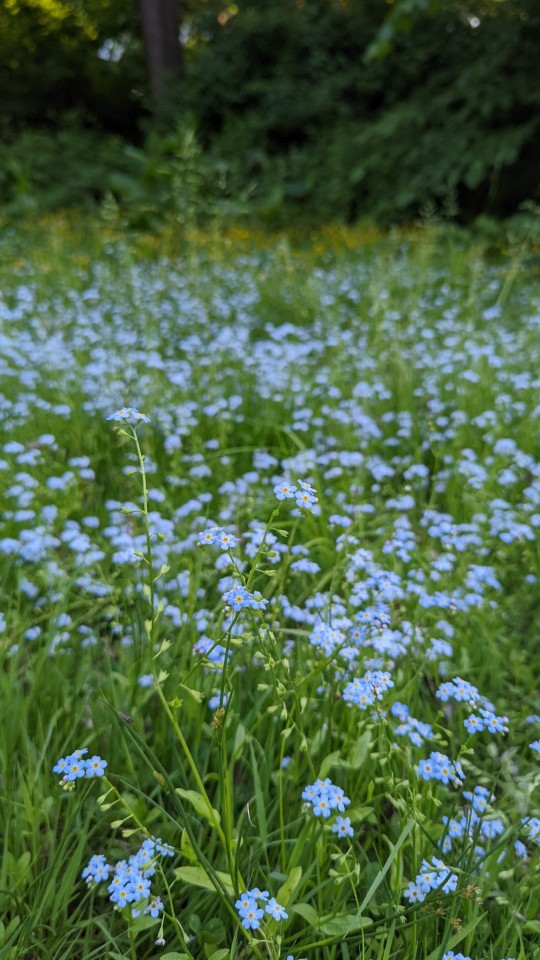



I don't like invasive flowers... but forget-me-not is unfortunately very pretty
#natureposting#nature aesthetic#naturecore#cottagecore#peaceful#aesthetic#flowers#blue#invasive species#cottage garden#cottage aesthetic
31 notes
·
View notes
Text

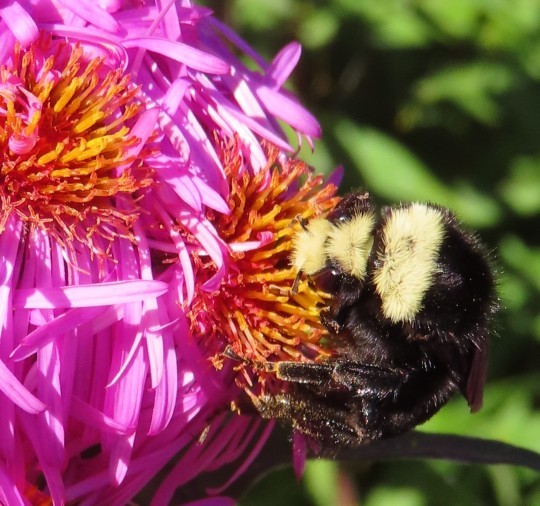

Bombus ternarius (orange-belted bumblebee), Bombus vosnesenskii, (yellow-faced bumblebee) and Bombus impatiens (common eastern bumblebee)
The bumblebee crisis
Bumblebees are under threat all over the world. Some European countries are reporting a 90% reduction in bumblebee populations in just the last few decades. Explanations include the usual list of suspects (pesticides, habitat loss and climate change) but here in Vancouver they also are experiencing pressure from a non-native bumblebee (Bombus impatiens). This species was brought in by agrobusiness to fertilize greenhouse crops such as tomatoes, peppers and cucumbers.
Before this problem began, greenhouse operators assured us that these imported bumblebees would not escape and compete with native bumblebees for nesting sites and resources (read: flowers). However, a recent report from UBC indicates that up to 40% of Vancouver area bumblebees are now Bombus impatiens (see photo number three).
Greenhouse operators have proposed 'queen bee excluder barriers' to prevent further escapees but I think it's a bit too late for that. I'm afraid "the horse has already left the barn" and poor, old Mother Nature will just have to cope with yet another man-made crisis.
#flowers#photographers on tumblr#bumblebees#Extinction Rebellion#invasive species#fleurs#flores#fiori#blumen#bloemen#my garden#Vancouver
105 notes
·
View notes
Text



So challenging to get good pics of Cosmos atrosanguineus. Took these this morning and I think they’re very true to life. No color/light editing needed.
62 notes
·
View notes